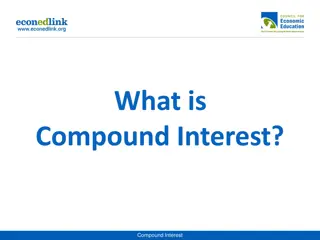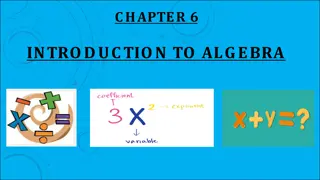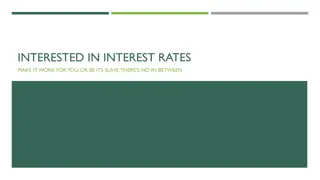Understanding Compound Interest in Advanced Financial Algebra
Compound interest refers to earning interest on both the principal amount and the accumulated interest. This concept is explored through examples of annual, quarterly, and daily compounding, showing how money grows over time based on different compounding frequencies. The formulas and calculations demonstrate how interest accrues and impacts the final balance in financial algebra.
Download Presentation

Please find below an Image/Link to download the presentation.
The content on the website is provided AS IS for your information and personal use only. It may not be sold, licensed, or shared on other websites without obtaining consent from the author. Download presentation by click this link. If you encounter any issues during the download, it is possible that the publisher has removed the file from their server.
E N D
Presentation Transcript
2-4 Explore Compound Interest Advanced Financial Algebra
What is Compound Interest? Principal (the amount of $ you deposit) increases each time interest is added to the account. Compound interest is when you earn interest on your principal AND on the interest that you already earned. There are different ways to compound interest: Annually (once each year) Semiannually (twice per year) Quarterly (four times per year) Monthly (12 times per year) Daily (365 times per year) Etc.
General Example Two Ways If you deposit $5,000 at 2% annual interest for the 3 years, how much money will you have at the end? SOLUTION: Year 1: $5000 + $100 interest = $5,100 at the end of year 1 $5000 (.02) = $100 interest for year 1 Year 2: $5,100 ( .02) = $102 interest for year 2 (earned interest on $5000 and on interest) $5100 + $102 interest = $5,202 at end of year 2 Year 3: $5,202 (.02) = $104.04 interest for year 3 $5202 + $104.04 interest= $5,306.04 at end of year 3
General Example short way If you had to figure that out for more than a few years, it would be too much work. Instead, we can use the formula we learned in the last chapter A = P (1 + ?)? Using that formula, we get the same answer. A(3) = $5,000 (1 + .02)3= $5,306.04
Example 1 annual compounding How much interest would $1,000 earn in 1 year at an annual rate of 2%, compounded annually? What would be the new balance? SOLUTION: Formula A = P (1 + ?)? Substitution A = $1,000 (1 + .02)1= $1,020.00
Example 3 quarterly compounding How much interest does $1,000 earn in 3 months at an interest rate of 2%, compounded quarterly? What is the balance after 3 months? SOLUTION: Quarterly is of a year, so you get of 2% interest 2%/4 = .5% per quarter Change that percent to a decimal .5% = .005 Use formula A = P (1 + ?)?= $1,000 (1 + .005)1 Balance after three months (one quarter) = $1,005.00
Example 4 daily compounding How much interest does $1,000 earn in one day at an interest rate of 2%, compounded daily? What is the balance after a day? What is the balance after one year? SOLUTION FOR ONE DAY: Daily is 1/365 of a year, so you get 1/365 of 2% interest 2%/365 = .00548% per day Change that percent to a decimal .00548% = .0000548 Use formula A = P (1 + ?)?= $1,000 (1 + .0000548)1 Balance after one day= $1,000.05
Example 4 SOLUTION continued SOLUTION FOR ONE YEAR: Daily is 1/365 of a year, so you get 1/365 of 2% interest 2%/365 = .00548% per day Change that percent to a decimal .00548% = .0000548 Use formula (t = 365 since there are 365 days in one year) A = P (1 + ?)?= $1,000 (1 + .0000548)365 Balance after one year= $1,020.20
Example 5 account balance Jennifer has a bank account that compounds interest daily at a rate of 1.2%. On July 11, the principal is $1,234.98. She withdraws $200 for a car repair. She deposits a $34 check from her health insurance company. On July 12, her $345.77 paycheck is directly deposited to her account. What is her balance at the end of the day on July 12? SOLUTION: Balance Withdrawal for car repair Deposit from insurance company Deposit Paycheck Balance before interest is added Calculate interest and get new balance $1,234.98 -$200.00 +$34.00 +345.77 $1,414.75 1,414.75(1+ .000033)1= $1.414.80 WORK: 1.2% /365 days in a year = .0033% = .000033 as a decimal for one day from 7/11 to 7/12
Assignment: pg 93 # 2, 5, 7, 10, 12, 13 #2 #5 Kevin has x dollars in an account that pays 2.2% interest, compounded quarterly. Express his balance after one quarter in an algebraic formula.
Assignment: pg 93 # 2, 5, 7, 10, 12, 13 continued #7
Assignment: pg 93 # 2, 5, 7, 10, 12, 13 continued #10
Assignment: pg 93 # 2, 5, 7, 10, 12, 13 continued #12 On May 29, Rocky had an opening balance of x dollars in an account that pays 1.3% interest, compounded daily. He deposits y dollars. Express his ending balance on May 30 algebraically. #13 Linda has d dollars in an account that pays 1.4% interest, compounded weekly. She withdraws w dollars. Express her first week s interest algebraically.























